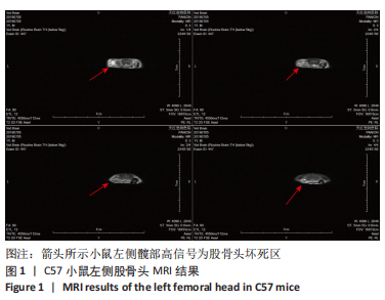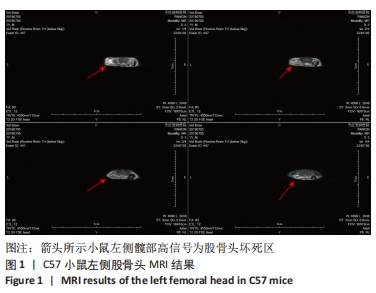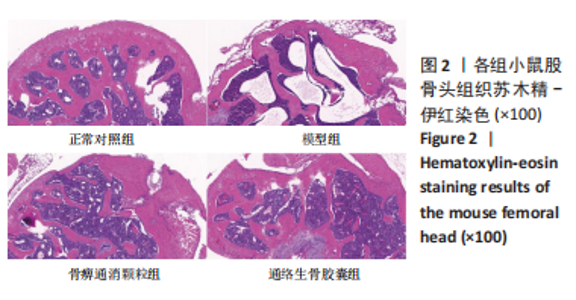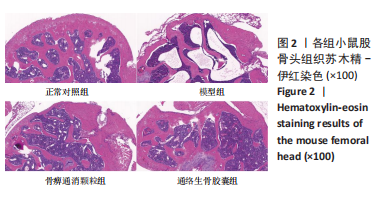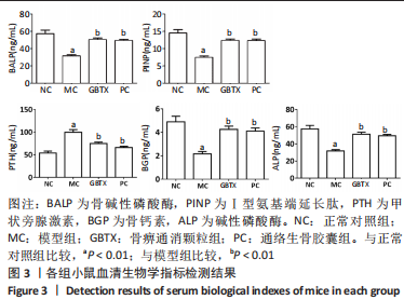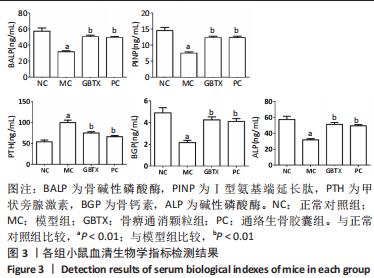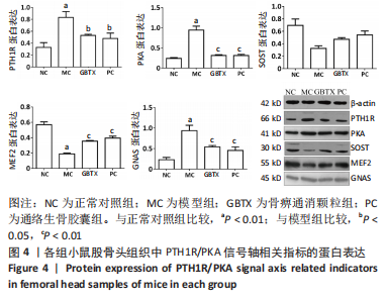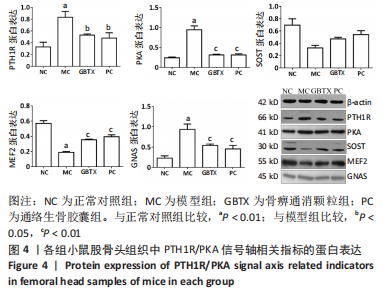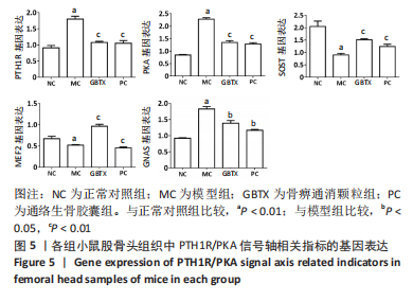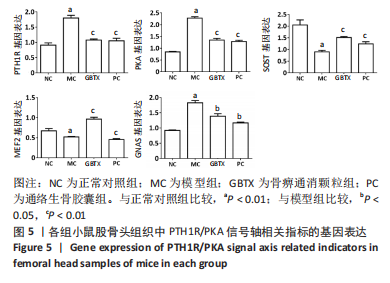[1] BI B, ZHANG S, ZHAO Y. The effect of robot-navigation-assisted core decompression on early stage osteonecrosis of the femoral head. J Orthop Surg Res. 2019;14(1):375.
[2] XU HH, LI SM, FANG L, et al. Platelet-rich plasma promotes bone formation, restrains adipogenesis and accelerates vascularization to relieve steroids-induced osteonecrosis of the femoral head. Platelets. 2021;32(7):950-959.
[3] 覃文涛,赵良军,胡阳,等.广西1951例股骨头坏死的流行病学研究[J].中华关节外科杂志(电子版),2021,15(3):261-266.
[4] SERONG S, HAVERSATH M, JÄGER M, et al. Prevalence of CAM deformity and its influence on therapy success in patients with osteonecrosis of the femoral head. J Tissue Eng Regen Med. 2019;13(4):546-554.
[5] 青少汀,葛宝丰,徐印坎.实用骨科学[M]. 4版.北京:人民军医出版社,2012.
[6] 中国医师协会骨科医师分会骨循环与骨坏死专业委员会,中华医学会骨科分会骨显微修复学组,国际骨循环学会中国区. 中国成人股骨头坏死临床诊疗指南(2020)[J].中华骨科杂志,2020,40(20): 1365-1376.
[7] 黄荣兰,胡文彬,詹庆昊.中医药通过调控骨代谢相关信号通路治疗股骨头坏死的研究进展[J].中国实验方剂学杂志,2021,27(8):241-250.
[8] 韩杰,谢小中,金万清,等.股骨头缺血性坏死保守治疗研究进展[J].辽宁中医药大学学报,2022,24(10):15-18.
[9] 封颖,颜泽栋,刘曦雨,等.甲状旁腺激素Ⅰ型受体在预防应力性骨折中的研究进展[J].生物技术通讯,2019,30(4):567-570.
[10] 彭启华,赵玉驰,王力刚.肌细胞增强因子2C与骨质疏松动物模型研究进展[J].黑龙江医学,2022,46(7):889-893.
[11] 骆帝,梁学振,阎博昭,等.补肾活血胶囊对激素性股骨头坏死大鼠骨破坏的修复[J].中国组织工程研究,2023,27(2):184-191.
[12] 罗智鸿,张程,何敏聪,等. 股骨头坏死患者骨密度与血清同型半胱氨酸和Ⅰ型胶原氨基端延长肽(P1NP)水平的相关性分析[C]//中国中西医结合学会骨伤科专业委员会.2019楚天骨科高峰论坛暨第二十六届中国中西医结合骨伤科学术年会论文集.2019楚天骨科高峰论坛暨第二十六届中国中西医结合骨伤科学术年会论文集,2019:753-755.
[13] 朱磊,周正新,顾一帆,等.阿托伐他汀对激素性股骨头坏死大鼠的作用及对Wnt/β-catenin信号通路的影响[J].中国现代医学杂志, 2022,32(24):34-39.
[14] 艾力江·阿斯拉,梁治权,李雷疆,等.补肾生骨汤对股骨头无菌性坏死大鼠的影响[J].中国中医骨伤科杂志,2023,31(1):7-12.
[15] 宋泽,周章武,周正新,等.丁锷教授治疗痹证常用药对举隅[J].甘肃中医药大学学报,2016,33(6):15-17.
[16] 朱玺,周正新.骨痹通消颗粒配合髓芯减压植骨术治疗早中期缺血性股骨头坏死的临床观察[J].中国民间疗法,2021,29(1):82-85.
[17] 韩士鼎,朱磊,周正新,等.中药骨痹通消颗粒联合髓芯减压植骨术治疗ARCOⅠ-Ⅱ期股骨头坏死临床疗效观察[J].中医药临床杂志,2021,33(8):1559-1562.
[18] 周正新,李文华,朱磊,等.中药骨痹通消颗粒干预激素性股骨头坏死模型兔的细胞凋亡[J].中国组织工程研究,2018,22(20):3190-3194.
[19] 袁普卫,殷继超,屈强,等.骨复生对家兔激素性股骨头坏死血清中甲状旁腺素的影响[J].辽宁中医杂志,2008,35(8):1262-1263.
[20] FANG B, LI Y, CHEN C, et al. Huo Xue Tong Luo capsule ameliorates osteonecrosis of femoral head through inhibiting lncRNA-Miat. J Ethnopharmacol. 2019;238:111862.
[21] 王金霞,贾可欣,明瑞蕊,等.通络生骨胶囊对糖皮质激素致血管内皮细胞功能损伤的保护作用[J].中国实验方剂学杂志,2021, 27(9):48-55.
[22] 帅波,马陈,沈霖,等.补肾活血方对激素性股骨头缺血性坏死小鼠肾素-血管紧张素系统经典轴的影响[J].中国中医骨伤科杂志, 2022,30(6):1-5.
[23] 赵云超,李晓明,王恒俊,等.丹参酮2A治疗股骨头坏死的作用机制研究[J].中国中医骨伤科杂志,2022,30(7):1-5.
[24] FAN ZQ, BAI SC, XU Q, et al. Oxidative Stress Induced Osteocyte Apoptosis in Steroid-Induced Femoral Head Necrosis. Orthop Surg. 2021;13(7):2145-2152.
[25] 魏伟,吴希美,李元建.药理实验方法学[M]. 4版.北京:人民卫生出版社,2010:69-72.
[26] 周明旺,刘一飞,吉星,等.基于“瘀去-新生-骨合”理论应用活血化瘀法治疗股骨头坏死的思路探讨[J].时珍国医国药,2020, 31(12):2988-2990.
[27] 陈彦同,周明旺,李盛华,等.基于“髓病理论”的非创伤性股骨头坏死发病机理探析[J].时珍国医国药,2020,31(7):1684-1686.
[28] YAN YQ, PANG QJ, XU RJ. Effects of erythropoietin for precaution of steroid-induced femoral head necrosis in rats. BMC Musculoskelet Disord. 2018;19(1):282.
[29] WANG A, REN M, WANG J. The pathogenesis of steroid-induced osteonecrosis of the femoral head: A systematic review of the literature. Gene. 2018;(671):103-109.
[30] 邱奕雁,郑羽晨,郭伟壮,等.cAMP/PKA/CITED1信号通路介导的甲状旁腺激素在骨代谢中的作用机制[J].中国临床研究,2020,33(1): 10-14.
[31] MARTIN TJ. PTH1R Actions on Bone Using the cAMP/Protein Kinase A Pathway. Front Endocrinol (Lausanne). 2022;12:833221.
[32] BURKE AB, COLLINS MT, BOYCE AM. Fibrous dysplasia of bone: craniofacial and dental implications. Oral Dis. 2017;23(6):697-708.
[33] LEUPIN O, KRAMER I, COLLETTE NM, et al. Control of the SOST bone enhancer by PTH using MEF2 transcription factors. J Bone Miner Res. 2007;22(12):1957-1967.
[34] FANG L, TANG B, HOU D, et al. Effect of parathyroid hormone on serum magnesium levels: the neglected relationship in hemodialysis patients with secondary hyperparathyroidism. Ren Fail. 2016;38(1):50-56.
[35] 王勤俭,李泊泊,董良杰,等.除湿虎潜丸加减联合髓芯减压术治疗Ⅰ,Ⅱ股骨头坏死湿热痹阻证的临床观察[J].中国实验方剂学杂志,2020,26(22):71-76.
[36] 张瀶曦,BALANI DH, TRINH S,等.间断或持续PTH刺激对骨及间充质干细胞的不同分化作用[J].中华医学杂志,2018, 98(10):781-787.
[37] 康斯文,侯德才.桃红四物汤对股骨头坏死患者BGP、BAP水平及血液流变学影响[J].辽宁中医药大学学报,2021,23(3):139-142.
[38] SHI Z, JIN H, DING Q, et al. Bone turnover markers may predict the progression of osteonecrosis of the femoral head in aged males. Ann Transl Med. 2019;7(22):626.
[39] 宋蒙胜,余霄,戎鹏泽,等.甲状旁腺激素经不同信号通路调节骨代谢的研究进展[J].中国骨伤,2021,34(6):584-588.
[40] LEE SK, LORENZO JA. Regulation of receptor activator of nuclear factor-kappa B ligand and osteoprotegerin mRNA expression by parathyroid hormone is predominantly mediated by the protein kinase a pathway in murine bone marrow cultures. Bone. 2002;31(1):252-259. |
